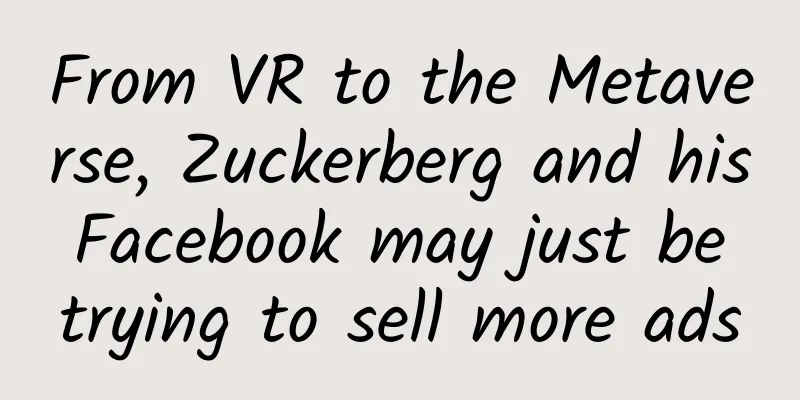Virtual Reality Entrepreneurship: How long will it take to see spring?

|
Virtual Reality (VR), a field that is somewhat unfamiliar to the public, has become popular again. A report issued by Superdata, a US data analysis company, shows that in 2014, $2.6 billion was invested in companies engaged in VR and augmented reality (AR) businesses and related projects. While international giants such as Facebook, Samsung, Microsoft, Google, and Sony are all making moves in this field, a large number of VR startups have also emerged around the world, and China is of course no exception. It seems that overnight, after Facebook acquired virtual reality device maker Oculus for $2 billion, this field, which is considered to be the "next generation computing platform", has become a new battlefield for major Internet companies to fight. However, now they are all busy "deploying their positions" and the tension between them is not that strong. What is Virtual Reality?For many people who have not been exposed to virtual reality, the word sounds a bit unreal and they don't know what use it can have. In short, virtual reality uses computer simulation to create a three-dimensional virtual world, providing users with simulations of senses such as vision, hearing, and touch, making users feel as if they are in the scene. The reason why virtual reality technology is popular again is that in the 1990s, a group of game companies launched a wave of virtual reality devices, but due to the limitations of the equipment itself and the industry as well as the excessively high prices, the virtual reality craze ultimately failed. Virtual reality technology has existed since the 286 era of computers. However, due to the computing power and equipment at the time, this field has remained unknown and has made no achievements in the consumer field for a long time. Its application scenarios are mostly in the enterprise market and the scale is very small. Today, with the rapid development of computer chip computing power and the popularization of mobile smart terminals, the field of virtual reality seems to be ushering in an important development turning point. The most well-known product in this field is the head-mounted display helmet, which can be roughly divided into two categories: PC VR and mobile VR. Representatives of PC include Oculus Rift, Ant Vision Helmet, UCglasses, etc., and mobile representatives include Google Cardboard, Samsung Gear VR, Baofeng Magic Mirror, etc. In addition, companies are currently involved in content production, application development, film and television production, game development, peripheral equipment and other fields, and are gradually forming a complete ecological chain. Large enterprises are busy with layout while small enterprises are busy with "occupying the market"The latest news shows that Google is secretly developing a virtual reality version of the Android system. Although Google does not admit it, the Wall Street Journal reported that dozens of Google engineers and other employees are working on this project. According to people familiar with the matter, Google began to build a team after Facebook acquired virtual reality device maker Oculus for $2 billion. Facebook CEO Zuckerberg believes that virtual reality will be the next wave of the Internet in the next decade. He said that he would build Oculus VR into a virtual reality platform and apply it to multiple scenarios in life. Microsoft's layout was to release the virtual reality technology Holograms and the corresponding device HoloLens in January this year. Microsoft has spared no effort in promoting it. All Windows 10 systems will have built-in Holograms API, and Microsoft will also port Xbox games to the HoloLens virtual reality headset. In addition, Sony announced its virtual reality headset "Project Morpheus" for the PS4 game console, HTC cooperated with game companies to launch the HTC Vive helmet, and Samsung cooperated with Oculus Rift to propose the Gear VR helmet. This round of layout by international giants was almost completed within this year, and it seemed that they all had the same intention to occupy the entrance first and build their own business platforms. The presence of giants has not frightened passionate entrepreneurs. Instead, to a certain extent, it has strengthened their confidence in virtual reality technology. Recently, a large number of entrepreneurs have emerged in various sub-sectors around the VR industry chain. In Zhongguancun, where entrepreneurs gather, a special park around virtual reality has also been opened with great fanfare. In the domestic virtual reality market, different types of companies are entering different VR fields. In the field of games, in addition to game developers such as Perfect World that have announced the development of VR games, there are also a large number of start-up teams such as Chaofan Vision Fantasy, Nibiru, and Galaxy Entertainment that are following up; in the field of content distribution, there are products such as Baofeng Magic Mirror App and Dream VR Assistant; in the field of peripheral equipment, there are also Virtuix's Omni somatosensory treadmill, Ant Vision somatosensory gun, and Noitom's full-body motion capture equipment. Both abroad and at home, the virtual reality industry chain is ushering in a new period of prosperity. Opportunities and ChallengesPeople who are not familiar with virtual reality generally have a concern that virtual reality will be another field that will burn money for a long time and has no profit point. This concern is understandable, because virtual reality technology has not yet been widely used in any market. However, good ideas are being discovered little by little. Facebook's latest plan may dispel some of your prejudices about virtual reality. After acquiring Oculus Rift, Facebook is considering changing the way people consume sports. Courtside seats for sports games are usually expensive, for example, a seat in the NBA Finals can sell for as much as $30,000. However, Oculus Rift and other virtual reality manufacturers are developing a technology that can create infinite seats, which allows sports providers to sell an unlimited number of "identical" seats. Of course, the price of these seats will not be as high as on-site tickets, perhaps only one percent of the price of on-site tickets, which may very likely prompt hundreds of people to be willing to spend some money to experience an immersive game. Theoretically, the number of people that can be accommodated in a virtual stadium is unlimited, and the commercial prospects are also very imaginative. The WASAI virtual reality experience center created by the domestic manufacturer Solar System Media is also an interesting exploration of a profit model. The only difference between this model, which is similar to an Internet cafe, and the Internet cafe is that users pay to experience virtual reality content, such as movies, games, etc. In addition, in commercial fields such as military, medical, aerospace, education, etc., the demand for VR technology has always existed and is growing. However, compared with the opportunities, the challenges currently facing this field are more severe. Take the commonplace issue of motion sickness and visual fatigue caused by helmets as an example. Almost all helmet manufacturers have built-in "roller coasters". Judging from the experience of many virtual reality helmets, the nausea and dizziness caused by the process have not been well solved. This problem also exists in the gaming experience. Strong dizziness will lead to a significant reduction in the use time. According to Baofeng Mojing's statistics, the current single usage time of its users is 6.5 minutes. The short usage time of users is a problem faced by the entire industry, and it is also a major argument for critics to doubt that virtual reality is a false proposition. Oculus Chief Technology Officer John Carmack once pointed out that their biggest concern is that unpolished VR products will make users feel physically uncomfortable. If users do not actually feel the charm of the expected products, the high hopes they had previously held will quickly disappear. A staff member of Tianshe Games, a virtual reality game development team established last year, told Sina Technology that they entered the virtual reality field because they were optimistic about its huge development potential in the future. "We believe that virtual reality will replace PCs and mobile phones and become a very important window for people to interact with information in their daily lives in the future." But they also have a big fear. These entrepreneurs are afraid that in the early stage of the market, users will give up their willingness to buy because they have no chance to experience virtual reality, or even leave a bad first impression because of the bad experience of virtual reality, which will make it difficult to cultivate this market again. "What virtual reality is most looking forward to is the emergence of a killer app, just like Fruit Ninja and Angry Birds on smartphones." Feng Xin, CEO of Baofeng Mojing, told Sina Technology that cultivating users is a long process, and if there is a killer app, it will be quickly popularized. He predicts that the virtual reality industry will explode within two years. In addition to the unsatisfactory experience, virtual reality still has hardware limitations. Take an application called "Paul Mccartney" developed by a foreign company as an example. This application contains a 3-minute live concert experience. After being shot by a spherical camera designed for shooting virtual reality scenes, the space occupied by the 1080P format reached more than 500M, and only mid-to-high-end smartphones can play it smoothly. This puts higher requirements on bandwidth and mobile phone performance. What is more noteworthy is that the VR industry currently lacks a unified standard. Although Google intends to recreate a unified system platform in the VR field, the launch date and whether other companies will buy in are still unknown. Different standards and different interfaces are actually a huge hurdle for developers. Once the wrong technical direction is chosen, the consequences may be serious. At present, giants continue to join the virtual reality market, and start-ups continue to receive financing. During this period, there will be a melee between giants and start-ups, and a stalemate between content and hardware. Virtual reality has become the next battlefield for global companies, but from the current perspective, each is still in a state of "encircling the land and preparing for war". Although the actions of major companies to seize the entrance have given us a hint of gunpowder, just as there is a real purpose behind every war, the war of virtual reality is first to cultivate the market and attract the attention of the public. Obviously, this is also a very painful process. Before we really see the spring of virtual reality, a large number of hardware and software companies may have gone bankrupt. Dialogue with entrepreneursSina Technology talked with several entrepreneurs when it came to understanding the field of virtual reality. As an emerging field, a number of companies that imitated foreign products emerged in China, but they were quickly eliminated due to the lack of core competitiveness. There are also good startups in China, and there are also second-time entrepreneurs, such as Baofeng Mojing, founded by Feng Xin. When it comes to entrepreneurship, if you don’t try, you don’t even have the chance to fail. When Sina Technology communicated with entrepreneurs, it found that unlike the wave of entrepreneurship 20 years ago, this wave of entrepreneurship is more clear in positioning and division of labor, and is more rational. The following are some excerpts from conversations with entrepreneurs: Storm Mirror Sina Technology: What types of helmets are available in the industry now, like Baofeng Mojing? Feng Xin of Baofeng: I think there are roughly three models. One is like Oculus, where there is a screen on the helmet, and all the calculations are done on the computer, which requires a connection. However, the greatest value of VR is to move, but the connection restricts the action, which is a paradox in itself. I think they will gradually abandon this model, because when they started, smartphones were not yet popular. The second type is a model like the Storm Mirror, which can be inserted into a smartphone. This reduces costs, but there are also some problems, such as making the overall weight of the helmet heavier. The third is to bring your own computing device, such as the Sony helmet. This model will provide a better experience, but the price will be higher. Sina Technology: What do you think of the domestic and international markets for VR? Feng Xin of Baofeng: We all need to find a single breakthrough point. I think the possibility of a domestic startup to have a breakthrough point is very low, on the contrary, more opportunities are in traditional game development companies. In foreign countries, most of the companies are giants, and small companies will be eaten up. Peripheral companies and content companies have a higher probability of success in the United States. I think the ideal explosion point is to make a small investment for a big return. A small game can bring the panoramic experience to the extreme. In addition, I think panoramic video will be a good breakthrough point. For example, after landing on the moon, astronauts walked around the moon with cameras, which would attract most people around the world to watch. This is determined by the content. I think the probability of an explosion in both quantity and quality in 2015 is higher. Sina Technology: How does Baofeng Magic Mirror plan its layout? Feng Xin of Baofeng: We will invest in companies with technology that make peripheral devices, as well as game platforms. We will choose to cooperate with and support content teams. In addition, we are also preparing a fund in the VR field, mainly investing in some content companies. Sina Technology: What were the main tasks of Baofeng Mojing in 2015? Feng Xin of Baofeng: Our biggest goal is to build a platform and strive to cultivate a user base of one million within half a year. We now have 210,000 users. We are also considering offline experiences, but the specific form has not yet been finalized because the biggest problem at the moment is that users don’t understand what virtual reality is. We will continue to update the software and hardware every 100 days. The next generation of Baofeng Magic Mirror will improve the immersion, such as removing the borders in the current picture, and also make the magic mirror lighter. I think the explosion of this industry will not exceed 2 years, and it is already just around the corner. I think BAT will start planning before 2016, and the reason why Baofeng Mojing chose to be independent is that it has plans for financing in the future. Entrepreneurial team extraordinary vision Sina Technology: Please briefly introduce your team. Chaofan Vision: We are currently exploring the direction of virtual reality content, such as games, but not just games. We have already released a product called "Single-plank Bridge". Our current team has 4 people and received some financing in mid-2014. Sina Technology: Why do you want to do VR? Super Vision: We like VR very much and want to do something for it. We have the ability to do it, so we did it without thinking too much. Later we found that what we like can become our job, so we might as well do it well and seriously. Sina Technology: What do you think is the most important thing for entrepreneurs? Super Vision: I think experience is the core. If you don’t start with experience, you may only be able to get the first wave of early adopters to buy in. When people try it, get disappointed, think VR is just so-so, or misunderstand the concept, then you may have ruined your future. From the perspective of game content, the proportion, height, speed of movement, size of the scene, interaction method, and even the color tone of the scene, etc., these factors will fundamentally affect the user experience. Sina Technology: What are your expectations for the VR field? Extraordinary Vision: VR is an opportunity. It can be combined with various industries and can easily cross the dimensions of time and space. When VR technology advances rapidly, everything you do is a process from 0 to 1, just like creating a new world, which is very exciting. Entrepreneurial Team NED Sina Technology: Please briefly introduce your team. NED: We are developing a head-mounted display that simulates the audio-visual effects of an IMAX cinema. Our team currently has seven people. The company was founded in February 2015. This project was started in May last year, and we have not yet considered financing. Sina Technology: What do you think is the current state of the hardware market? NED: There is an interesting phenomenon in the current Chinese market: a large number of game engineers want to enter the field of virtual reality development, but are hesitant when faced with the small number of virtual reality hardware users; on the other hand, hardware companies hope that a large number of game developers will enter the field of virtual reality content and application development to enable users to get more experience. However, the hardware products still give users the feeling of being in the most basic and immature stage, including the existence of dizziness and other problems, which leads to the market phenomenon of being praised but not sold. I think virtual reality devices should not be what they are now. There must be better hardware solutions. Sina Technology: Are you confused and worried? NED: Currently, giants continue to join the VR market, and start-ups continue to receive financing. During this period, there will be a melee or reshuffle between giants and start-ups, and a stalemate between content and hardware. This process is painful and is expected to take about two years of running-in time. What is worrying is that a number of hardware and software companies will die during this period. Sometimes we are confused about our choice of direction because we can only choose one direction for in-depth operations with limited resources. If we had chosen VR, we would have faced direct competition with giants. Entrepreneurial Team Tianshe Sina Technology: Please briefly introduce your team. Tianshe: We are a virtual reality game development team established last year. We are now focusing on the development of virtual reality game content and have completed our angel round of financing. Sina Technology: What are your advantages? Why did you enter the VR field? Tianshe: Our team has a lot of experience in 3D game development. We also use our own demos to test the needs and concerns of end users. In 2014, we received 1,200 testers in just four days at Chinajoy to experience our own demos. We entered the field of virtual reality because we are optimistic about its huge development potential in the future. We believe that virtual reality will replace PCs and mobile phones and become a very important window for people to interact with information in their daily lives in the future. Sina Technology: There are many startups emerging in the VR field now. What kind of companies do you think will be eliminated? Tianshe: Virtual reality hardware will enter the Warring States period first. Hardware teams without great product and operational highlights and strengths will be squeezed out by the market. In terms of content development, the early stage competition is about creativity and execution. Before the number of virtual reality users reaches tens of millions, content development startup teams will have more room to exert their creativity to expand their own brands and cultivate their own user base. Sina Technology: What do you look forward to in the future, and what do you fear? Tianshe: We expect that virtual reality-related wearable hardware will become better and better and cheaper, so that virtual reality can truly enter thousands of households and become a large platform comparable to mobile devices. Our biggest fear is that users will not have the opportunity to truly experience good VR. The VR experience cannot be described in words, and the magic of immersion cannot be quantitatively analyzed with data. If users give up their willingness to buy VR in the early stages of the market because they do not have the opportunity to experience VR, or even have a bad first impression because of a bad VR experience, it will be difficult to cultivate this market again. As a winner of Toutiao's Qingyun Plan and Baijiahao's Bai+ Plan, the 2019 Baidu Digital Author of the Year, the Baijiahao's Most Popular Author in the Technology Field, the 2019 Sogou Technology and Culture Author, and the 2021 Baijiahao Quarterly Influential Creator, he has won many awards, including the 2013 Sohu Best Industry Media Person, the 2015 China New Media Entrepreneurship Competition Beijing Third Place, the 2015 Guangmang Experience Award, the 2015 China New Media Entrepreneurship Competition Finals Third Place, and the 2018 Baidu Dynamic Annual Powerful Celebrity. |
<<: Baidu Cloud OS is dead, where will Tencent and Alibaba go next?
>>: Black car taxi: a good taxi is one that you can get
Recommend
How to operate an APP software online?
In general, app operations are divided into two a...
Liu Feng丨Like humans, airplanes also get tired
In the experiment, The fuselage and wing structur...
Why don’t hotels check rooms nowadays? What should I do if something is lost?
In recent years, many people have found that chec...
【Latest】Baidu incentive video product introduction and delivery skills
Today I would like to introduce Baidu Incentive V...
Technology giants are entering the "metaverse" one after another. Does "Ready Player One" predict the future of the Internet?
In 2021, the concept of "metaverse" sud...
Dismantling the virtual product project of Baidu's high-profit blue ocean, with a profit of 300+ per order
Friends who work in the Internet industry know th...
Google Brain's founding member resigned, and he also broke up with Jeff Dean
This article is reprinted with permission from AI...
How to use data analysis to acquire customers at low cost?
This article is organized as follows: How to exte...
Suzhou SEO training: User experience determines the effectiveness of corporate website SEO optimization
In the process of optimizing SEO, we always empha...
How to solve the problem of users’ independent dissemination and sharing in APP operation?
Are you a good APP operator ? How many users does...
Wisteria snacks are a delight, and eating them till you are exhausted
In mid-April, between Qingming and Guyu, the wist...
Website seo diagnostic report, website search engine optimization diagnostic analysis report!
A good website SEO diagnosis report can be regard...
A review of the top ten events in China's space industry in 2021
Let us review the top ten exciting moments in Chi...
Earthworms don’t live in water, so why do fish like to eat them?
Author: Su Chengyu The article comes from the Sci...
What impact does big data have on mobile app development?
"What kind of application is a great applica...









